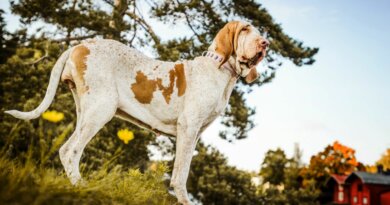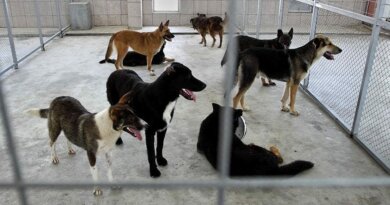10 Top Hypoallergenic Dog Breeds
Aaachoo!
For many allergy sufferers, a sneeze is just the start when they’re around a dog. The presence of a canine can also trigger coughing, wheezing, itchy eyes, and a stuffy nose.
If this sounds like you, the idea of adding a dog to your family may seem impossible — but it doesn’t have to be!
Certain dogs are bred specifically for their nonshedding coat, which produces less dander, the most common culprit behind dog allergies. These breeds are called hypoallergenic, and while no dog is 100% guaranteed to be allergy-free, they have allowed many allergy sufferers to bring the joy of a pup into their lives.
What is a Hypoallergenic Dog?
Certain breeds, known as hypoallergenic dogs, can still allow some people with dog allergies to enjoy canine companionship. A hypoallergenic dog breed is less likely to trigger allergic reactions in people sensitive to dogs. These particular breeds shed less dander and fur, produce lower amounts of potential allergy-causing proteins, and are generally better tolerated by those with canine allergies. Those hoping to add an allergy-friendly dog to their family must be prepared for these breeds’ grooming requirements and costs.
Consultation with medical professionals and breeders is recommended to determine if a specific breed would be a good fit. With the right breed match and preparations, dog lovers with allergies can find a compatible canine companion.
Ten of the Most Popular Dog Breeds That Are Hypoallergenic
Below is a list of hypoallergenic canines for future Pack Leaders to consider adding to their home.
Small Hypoallergenic Dogs
Bichon Frise
These pups are known for being upbeat and easy to train, but many allergy sufferers may overlook them because of that poofy hair. Don’t be fooled! Bichon Frises don’t shed, though they require regular grooming since their hair grows.
Yorkshire Terrier
This little guy is perfect for apartment dwellers since they don’t have high exercise needs (but, of course, they still need their daily walks!). The breed doesn’t shed but does require regular grooming to care for those long locks.
Italian Greyhound
With such a thin coat, it’s no surprise that this playful fellow sheds little to no fur. But be aware that its jacket makes it more sensitive to cold temperatures. Keep him bundled during the winter months to keep him safe.
Chinese Crested
The Chinese crested dog can be hairless or powder puff, but both varieties are considered hypoallergenic. These small pups are known for being family-friendly and often a little odd-looking.
Maltese
Fearless and small, the Maltese have long, silky white locks that require daily brushing. This breed is a good match for allergy sufferers looking for a lap dog.
Medium Hypoallergenic Dogs
Bedlington Terrier
The Bedlington terrier might be the next best thing if you always wanted a little lamb like Mary’s. Gentle and affectionate, their white, wooly coat doesn’t shed.
Wheaten Terrier
This active breed has a silky, soft coat that requires daily grooming to prevent matting. If you’re up to the task, you’ll find a dynamic and family-friendly companion in the wheaten terrier.
Schnauzer
The schnauzer can be a good pick for allergy sufferers, whether in standard, giant, or miniature size. These social pups don’t shed, though they need their hair regularly brushed to prevent matting.
Large Hypoallergenic Dogs
Portuguese Water Dog
This breed entered the limelight when the first family adopted the Portuguese water dog, Bo. Still, even if you don’t live at the White House, this hypoallergenic dog might be a good fit if you can provide rigorous daily exercise.
Poodle
This intelligent and active breed comes in three sizes: standard, miniature, and toy. Their coat is hypoallergenic but also requires regular professional grooming to upkeep.
What Makes a Dog Hypoallergenic?
Dog breeds considered hypoallergenic tend to shed less and produce fewer allergens that trigger symptoms in people. These breeds cause fewer problems for those with dog allergies. Below are some reasons why a dog is labeled allergy friendly.
- Produce less dander – Dander consists of tiny flakes of skin and protein that dogs naturally shed. Dander floats in the air and can trigger allergic reactions when inhaled. Hypoallergenic dogs produce less dander overall.
- Shed less fur – Fur contains proteins that can cause allergic reactions. Dogs like poodles have hair that sheds significantly less than fur from other breeds. Less shedding means less fur and dander in the environment.
- Have hair instead of fur – Hair is different from fur in structure and composition. Hair does not shed seasonally and causes fewer allergic reactions. Breeds with hair include poodles, Portuguese water dogs, and bichon frise.
- Saliva contains fewer allergy-triggering proteins – Some dogs produce lower levels of proteins like Can f 1 in their saliva. These proteins are less likely to cause a reaction when a dog licks someone. This makes the dog’s saliva less allergenic.
Considerations of Owning a Hypoallergenic Dog
While hypoallergenic dogs can allow allergy sufferers to enjoy canine companionship, prospective owners must carefully consider the responsibilities and lifestyle adjustments required. Before bringing one of these unique breeds home, pet owners should thoroughly research the needs of the grooming, exercise, training, and nutrition to ensure they can adequately care for the dog and control allergen exposure.
Expense of Breed
Some hypoallergenic dog breeds like poodles, Portuguese water dogs, and bichon frises can be pretty costly to purchase initially from reputable breeders. Prices often start around $1000-2000 for a hypoallergenic puppy. While the companionship of these breeds is priceless, Pack Leaders should carefully weigh the higher financial commitment required to care for certain allergy-friendly dogs.
Grooming Requirements
Caring for these breeds requires regular expensive grooming. Trips to a professional groomer every 4-6 weeks quickly add up, costing $50-100 per session. Daily brushing and frequent bathing with specialty shampoos also contribute to the overall expense.
Temperament and Activity Needs
When considering a hypoallergenic dog, it’s imperative to research the breed’s typical temperament and activity requirements. For example, poodles and schnauzers often have lively, energetic personalities requiring daily vigorous exercise. Portuguese water dogs are working dogs that need a job to do and extensive activity. In contrast, breeds like Maltese and bichon frises tend to have more easygoing dispositions well-suited to moderate exercise and play. Small, hypoallergenic breeds may be prone to bark or challenging to house train. Reviewing breed standards and matching those traits with your lifestyle helps avoid problems down the road. While allergy tolerance is a priority, prospective owners must ensure the hypoallergenic dog’s personality and energy level is a good family fit.
Nutritional Needs Specific to Breed
Diet is another consideration, as some hypoallergenic dogs may require high-quality veterinary-prescribed foods. When bringing home a new furry friend, discussing their dietary requirements with your veterinarian is essential. Some breeds may benefit from specially formulated diets with hydrolyzed proteins to reduce potential allergens.
High-quality limited, ingredient diets without common triggers like chicken, beef, dairy, or eggs may also be recommended. Hypoallergenic dogs have sensitive stomachs and may require grain-free nutrition. Consult your vet on an optimal food for your breed’s needs. Stick to the recommended feeding guidelines and monitor for signs of food allergies like itching or gastrointestinal upset. Proper nutrition tailored to your hypoallergenic pup will help support their health and your allergy management.

Tips for Managing Allergies
Bringing home a hypoallergenic dog breed can open up dog ownership to those with allergies. While most allergy-friendly dogs produce fewer allergens, they still require diligent management to keep allergens at bay. Implementing certain care practices and lifestyle adjustments can help allergy sufferers thrive with a hypoallergenic furry friend. Regular bathing using specially formulated dog shampoos removes dander, saliva, and pollen that may accumulate on the dog’s coat. Brushing and combing removes hair and allergens as well.
Vacuuming carpets and washing bedding frequently also helps capture irritants. Some may benefit from keeping dogs off furniture and designating non-carpeted areas. Air purifiers with HEPA filters can also trap substances in the air. While finding the right hypoallergenic match is critical, combining innovative management steps allows dog lovers with allergies to manage their symptoms and enjoy life with their pup.
How Can You Identify Dogs That Are Allergy Free?
Determining if a dog is hypoallergenic can be challenging for those with dog allergies looking to add a canine companion to their family. While certain breeds like poodles and wheaten terriers are marketed as hypoallergenic, the reality is that every dog produces at least some allergens. There is no 100% guarantee when it comes to dogs and allergies.
However, paying attention to specific characteristics of the breed, coat, grooming needs, shedding amount, pedigree history, and individual reactivity can help assess the likelihood of a dog causing fewer allergic reactions. Reputable breeders should provide documentation of multi-generational hypoallergenic lineages as well. Meeting a potential dog first to see if any symptoms arise is advised. While the perfect nonshedding hypoallergenic match comes with no absolute assurances, being informed and setting reasonable expectations allows dog lovers with allergies to find less allergenic canine companions successfully.
Do you own a hypoallergenic breed? How do your allergies fare? Share your experience in the comments.




